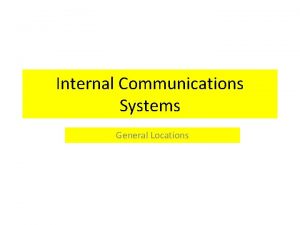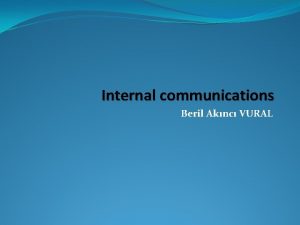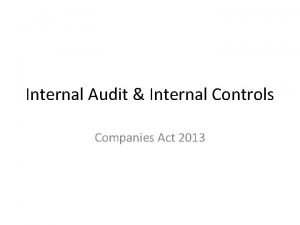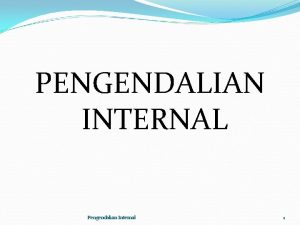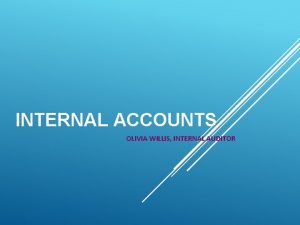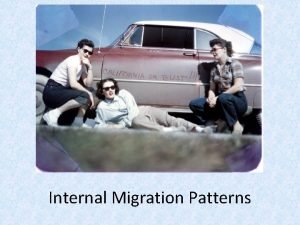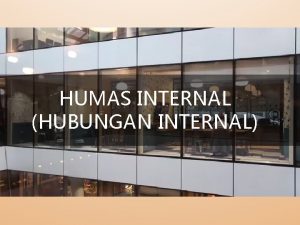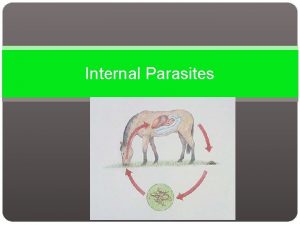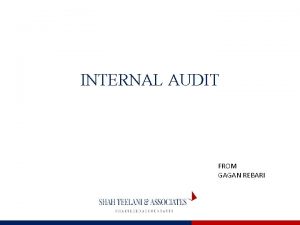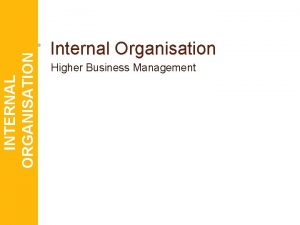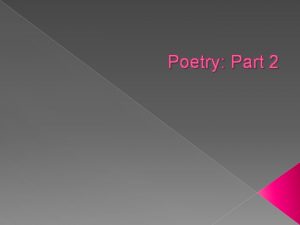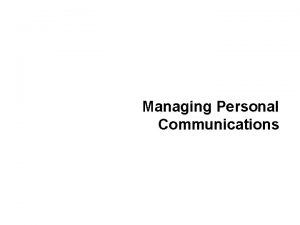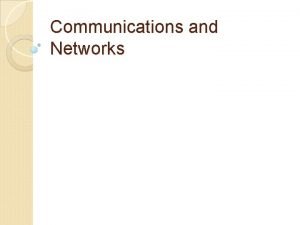Internal Communications At the end of this unit









































- Slides: 41

Internal Communications

At the end of this unit you should be able to 1. Recognise how information flows within an organisation 2. Identify formal and informal communication structures within an organisation 3. Discuss the importance of keeping open channels of communication 4. Identify specific channels/media of communication and their usefulness in particular situations 5. Conduct a communication audit on a business or organisation

What we will look at in this unit • Formal Communication Structures – Organisation Chart • Communication Flow – up, down, lateral, • Informal Communication – grapevine • Communication media – – Types – which to choose • Internal communications audit

Internal Communication • refers to the exchange of information that occurs among people within the organisation • good internal communication systems necessary for efficient functioning

Why is internal communication important?

Why is internal communication important? • • • Essential to functioning of organisation Creates understanding-objectives & roles Improves culture Job satisfaction Safety Decrease litigation, staff turnover & absenteeism

FORMAL Internal Communication STRUCTURES • Sanctioned by management • Follow predictable paths • LIST examples of formal internal communication structures.

Organisational Chart

Task: Organisation Chart Identify an organisation to which you belong or have belonged. Sketch the organisational chart. 1. Is it tall or is it flat? 2. Does the chart reflect the organisations culture? 3. What are the strengths and weaknesses of the structure?


Communication Flow - 3 basic directions 1. Downwards 2. Upwards 3. Laterally 4. Diagonally

Information Flow in a Retail Organisation CEO/Board Regional Managers Strategic information Store Managers Commercial Managers Section Managers Staff Operational information

Downward Communication • Information about the organisation’s mission, values, strategic goals • Employee handbook • Standard operating manual • Job descriptions • Information about major accomplishments, concerns, announcements, audits, etc • Operational issues and decisions

Downward communication STRENGTHS WEAKNESSES

Downward communication STRENGTHS WEAKNESSES • Establishes clear lines of authority and who does what! • Logical way to keep employees informed • Can motivate employees towards the organisations vision & strategy • Employees get to know managements view • Message gets diluted or distorted • Wrong channel may be used • Messages may be withheld or manipulated • Could damage morale • Information overload • Problems with accuracy, consistency, completeness

Barriers to Downward Communication • Resistance from managers • Information overload • Organisation structure – e. g. tall organisation with many levels of management • Organisation culture/ management style – e. g. very formal bureaucratic culture; closed, secretive management style

Upward Communication • Status reports, reports to management • Notification of problems • Complaints/ grievances • Ideas and suggestions • Attitudes

Upward communication STRENGTHS WEAKNESSES

Upword communication STRENGTHS WEAKNESSES • Invaluable source of new ideas & information for managers • Enables employees to participate • Motivates employees • Empowers employees 1. Employees playing politics 2. Fear of speaking your mind 3. Managers hearing but not listening 4. Gatekeeping 5. Added frustration

Reasons for Poor Upward Communication Fear of reprisal Filters • Employees are afraid to speak their minds • Employees fear their ideas will be changed or stolen as they are transmitted upwards Covering up • Employees hide mistakes Ingratiation • ‘Licking up’ to the boss

Lateral Communication • horizontal communication between staff at the same level in the organisation. It is used for: • Liaising and co-ordinating activities • Sharing information and ideas, expertise and best practice


Lateral communication STRENGTHS WEAKNESSES

Lateral communication STRENGTHS WEAKNESSES • Strengthens teamwork • Spreads knowledge, skill & expertise • Reduces dependence on management • Contributes to positive atmosphere of mutual support • Cliques could form and shut others out • Employees may feel managers need to be more involved • Employees may find it difficult to cope with continuous later communication • May not work in a competitive environment

Reasons for Poor Lateral Communication • Increased specialisation of organisation subunits • Problems with language - different ‘jargon’ • Power rivalries and gate-keeping

Diagonal Communication • communicating with someone who is • not at the same level in the organisation and • not in direct chain of command

Diagonal Communication

Diagonal communication STRENGTHS WEAKNESSES

Diagonal communication STRENGTHS WEAKNESSES • Reduces barriers between departments • Increase knowledge flow between departments • Creates better understanding between departments thus increasing overall team effort • May offend your manager • May not be appropriate to communicate in this way • May cause rivalry if two departments become very close at expense of others • Important information may not get communicated upward/downward

Task: Communication Flow Think about your organisation earlier 1. What direction does communication flow in this organisation? 2. How effective are they? 3. What are the barriers to communication?

Informal Communication • Pathways of daily interaction • Dependent on social relationships

The Grapevine In favour of Against

The Grapevine In favour of Against • Messages travel quickly • Often the only source of vital information • Some say mainly accurate • Builds cohesiveness • Creates culture • Test bed • Natural & relaxed • Information follows an unpredictable path • Usually some element of distortion • Information unrecorded • Some people may be bypassed or excluded • Can be damaging

The Grapevine Clique 1 Clique 2 Isolate Clique 3 Clique 4


Task: I heard it through the grapevine ! 1. What information do you receive informally in your organisation? 2. What information did/do you receive informally as a student?

‘The Medium is the Message’Marshall Mc. Luhan Key decisions 1. What is the PURPOSE? 2. Who are my AUDIENCE? 3. Which is the most effective channel of communication (MEDIUM)?

When choosing a Medium…. . Consider…………… • • • Speed Distance Quantity Intimacy Talent

Task: Your choice of media? 1. List as many media types used by organisations. 2. Give examples when to use each type for communication in an organisation.

Internal Media Formal Informal Other Intranet Email Intercom Meetings- many Instant messaging (IM) (Electronic) notice board types/ Briefings Manuals/reports/ Informal meeting memos/letters Magazine/ezine Informal chat Corporate video

Summary- Internal Communications • Good communication essential to organisational functioning • Formal & informal communication • Choosing appropriate medium critical to effectiveness of message
 Internal communications system
Internal communications system Unit 2 communication
Unit 2 communication End-diastolic volume vs end-systolic volume
End-diastolic volume vs end-systolic volume Stroke volume ejection fraction
Stroke volume ejection fraction Compiler front end and back end
Compiler front end and back end Compiler front end back end
Compiler front end back end Kolondivertikulose definition
Kolondivertikulose definition End-to-end wireframe parsing
End-to-end wireframe parsing End to end argument
End to end argument End to end accounting life cycle tasks
End to end accounting life cycle tasks Protect
Protect End to end delay
End to end delay End to end
End to end Comet commonsense
Comet commonsense Multiple procurement cycles
Multiple procurement cycles Unit 6 review questions
Unit 6 review questions Difference between internal check and internal control
Difference between internal check and internal control Importance of vouching
Importance of vouching Hát kết hợp bộ gõ cơ thể
Hát kết hợp bộ gõ cơ thể Ng-html
Ng-html Bổ thể
Bổ thể Tỉ lệ cơ thể trẻ em
Tỉ lệ cơ thể trẻ em Chó sói
Chó sói Glasgow thang điểm
Glasgow thang điểm Alleluia hat len nguoi oi
Alleluia hat len nguoi oi Môn thể thao bắt đầu bằng chữ đua
Môn thể thao bắt đầu bằng chữ đua Thế nào là hệ số cao nhất
Thế nào là hệ số cao nhất Các châu lục và đại dương trên thế giới
Các châu lục và đại dương trên thế giới Công thức tính thế năng
Công thức tính thế năng Trời xanh đây là của chúng ta thể thơ
Trời xanh đây là của chúng ta thể thơ Mật thư tọa độ 5x5
Mật thư tọa độ 5x5 Làm thế nào để 102-1=99
Làm thế nào để 102-1=99 độ dài liên kết
độ dài liên kết Các châu lục và đại dương trên thế giới
Các châu lục và đại dương trên thế giới Thể thơ truyền thống
Thể thơ truyền thống Quá trình desamine hóa có thể tạo ra
Quá trình desamine hóa có thể tạo ra Một số thể thơ truyền thống
Một số thể thơ truyền thống Cái miệng bé xinh thế chỉ nói điều hay thôi
Cái miệng bé xinh thế chỉ nói điều hay thôi Vẽ hình chiếu vuông góc của vật thể sau
Vẽ hình chiếu vuông góc của vật thể sau Nguyên nhân của sự mỏi cơ sinh 8
Nguyên nhân của sự mỏi cơ sinh 8 đặc điểm cơ thể của người tối cổ
đặc điểm cơ thể của người tối cổ Thế nào là giọng cùng tên?
Thế nào là giọng cùng tên?
